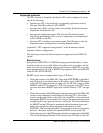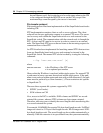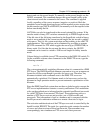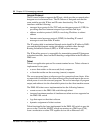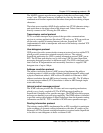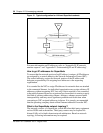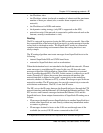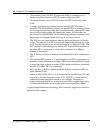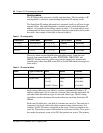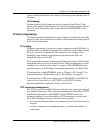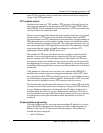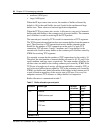
Chapter 2: EIU messaging protocols 57
DMS-100 Family EIU User Guide TELECOM12
• the IP address class
• the IP address subnet size based on number of subnets and the maximum
number of hosts per subnet (also, consider future expansion of the
network)
• the IP addresses for HUBs and routers
• the dynamic routing strategy (only RIP is supported on the EIU)
• network security (if the network is connected to public network such as the
Internet, security consideration is vital)
Routing
The IP is a network layer protocol using the ISO seven-layer model. One of the
key responsibilities of the network layer protocol is to route messages from the
source node to destination nodes. The SuperNode IP works in a somewhat
complex inter-networking environment where the routing decision is not
always simple.
The IP routing algorithm must route messages from SuperNode hosts to the
following:
• internal SuperNode SOS and UNIX-based hosts
• external-to-SuperNode hosts such as workstations
When the destination host is not attached to the SuperNode network
2
, IP must
route messages to a neighboring IP router. In this way, IP forwards route
messages toward the final destination. SuperNode connectivity to external
hosts is possible through EIUs. The EIU, in this context, is referred to as an IP
router. Generally, IP routers have more than one network interface (the
network interface is defined as the node’s connectivity to the underlying
network, whether it is Ethernet or FTS), to allow IP messages to pass from one
network to another. The IP router may also provide connectivity to networks
with distinct architectures. The EIU is one such IP router.
The EIU acts as the IP router between the SuperNode hosts (through the FTS
network interface) and the Ethernet LAN (through the Ethernet interface). The
EIU receives and forwards messages between the Ethernet LAN and the
SuperNode hosts. Some unique characteristics of SuperNode IP routing are as
follows:
• IP messages destined from one SuperNode host to another SuperNode host
within same SuperNode are sent directly without any intermediate nodes
as routers or gateways.
• IP messages destined to hosts on the LAN are sent through one of the
available (in service) EIU IP routers connected to that LAN.
2. A SuperNode network is the network of SuperNode hosts reachable through FTS.



